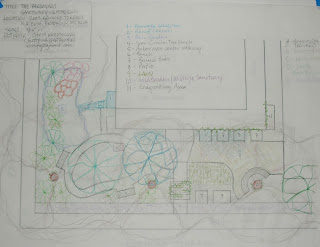To get started, grab a measuring tape and record the dimensions of your garden. Then use a ruler and a piece of sketch or graph paper to draw the outline of your garden. To draw your garden to scale, assign a certain length to equal one inch. For example, if your garden is twenty feet long, you can set 1 inch equal to two feet. Using graph paper is even easier because the quadriles are already on the page. Also, if you're interested in creating your design online instead of on paper, you can use free design tools like Google Sketch-Up to create your garden.
After the outline of your garden is drawn, you can create stencils or symbols to represent your plants. If you would like, you can buy gardening or landscaping stencils, or you can go online and download pre-made symbols (see the link below for gardening symbols). Just print the symbols on card stock, cut them out, and use them to trace your design.
Before you begin populating your garden with symbols, remember to make a plant key! A plant key is very important because it will help you organize your ideas and your design. It is invaluable when it's time to start planting, because it is difficult to remember the ideal location for every plant and your helpers can find the plant location directly from the chart.
After your outline, symbols, and key have been made you can begin to design your garden. Remember to keep the principles we have recently discussed in mind: intercropping plant species, incorporating pollinator-friendly and pest-deterring plants, and crop rotation (to confuse pests). Also, keep spatial and height elements in mind when planning your garden. Taller plants and those that need trellising should be placed near walls or toward the back of the garden so they do not block the sunlight needed by low and medium height plants.
Remember to add some color to your design. Shrubs and vines can be given a dark green color, while sunflowers can be bright yellow. A garden design is a practical way to organize a garden, but it can also be a fun way to get your creative juices flowing. Your final design can become an artful homage to your edible landscape!
Photo of garden design courtesy of Chris Kreussling

Try using some of these symbols from the University of Minnesota: http://www.google.com/imgres?imgurl=http://www.sustland.umn.edu/design/images/landscapesym2.gif&imgrefurl=http://www.sustland.umn.edu/design/lanscapesym.html&usg=__HDT3tT0S076F0OirIIEK8QS6b28=&h=770&w=600&sz=57&hl=en&start=5&zoom=1&tbnid=Gb4v_FnVJOpKfM:&tbnh=142&tbnw=111&ei=Ia0ZT9-WDurg0QHW_e3fBA&prev=/search%3Fq%3Dplant%2Bsymbols%26um%3D1%26hl%3Den%26sa%3DN%26rls%3Dcom.microsoft:*:IE-SearchBox%26rlz%3D1I7ADFA_en%26tbm%3Disch&um=1&itbs=1
No comments:
Post a Comment